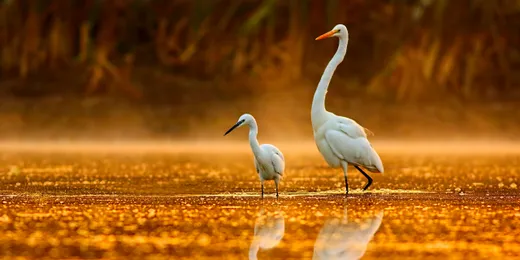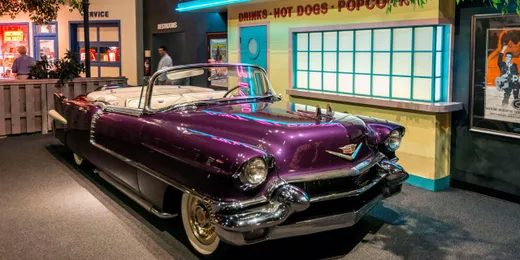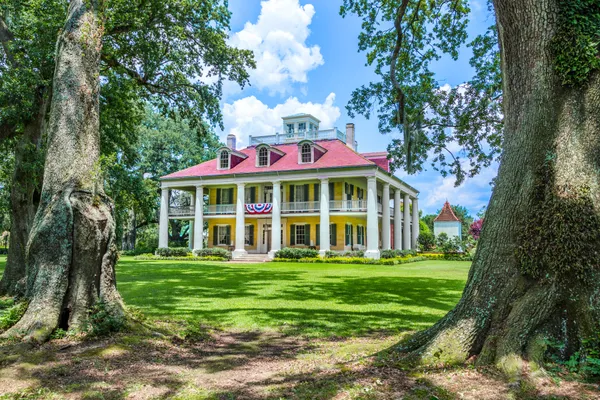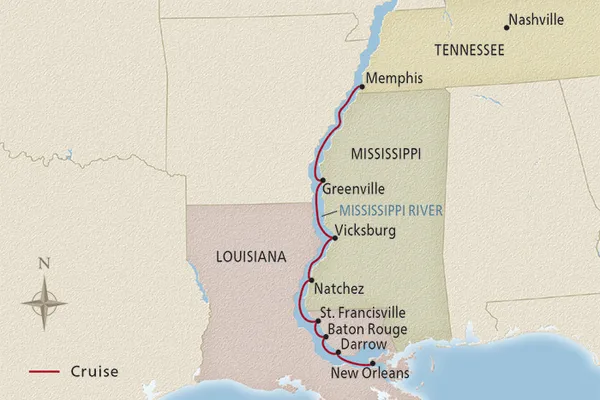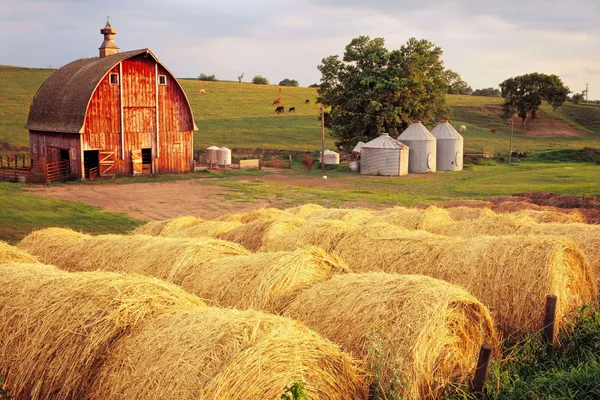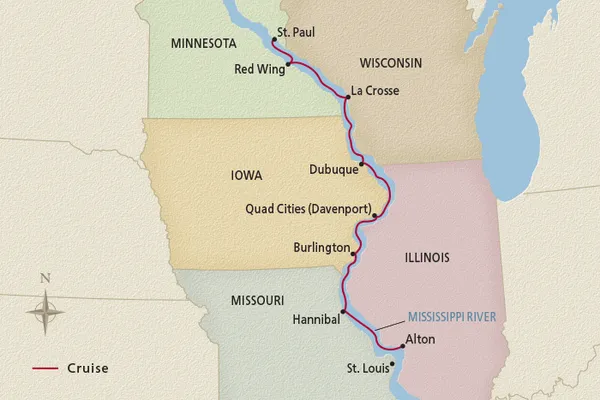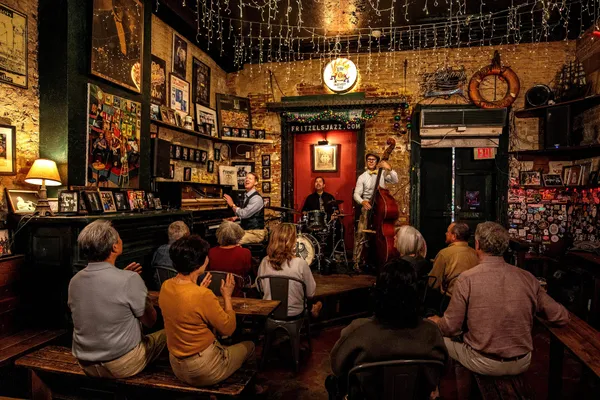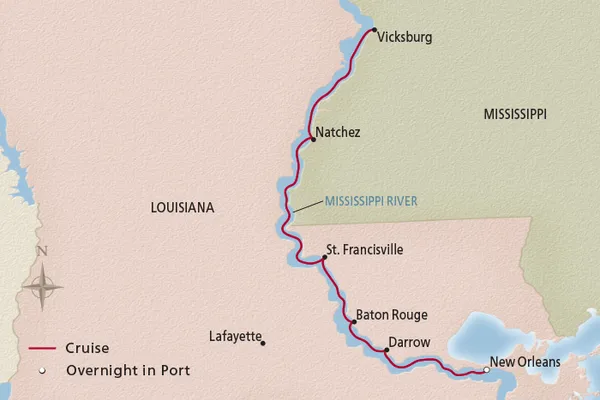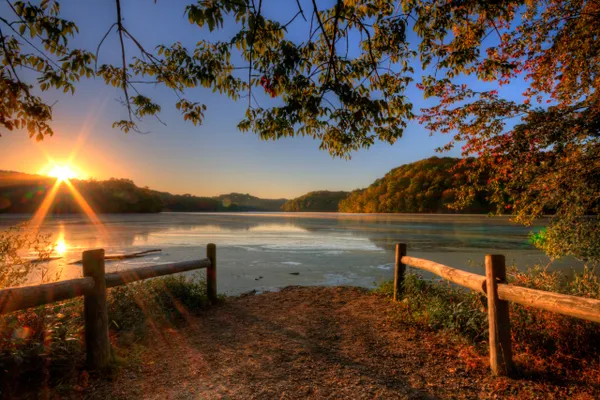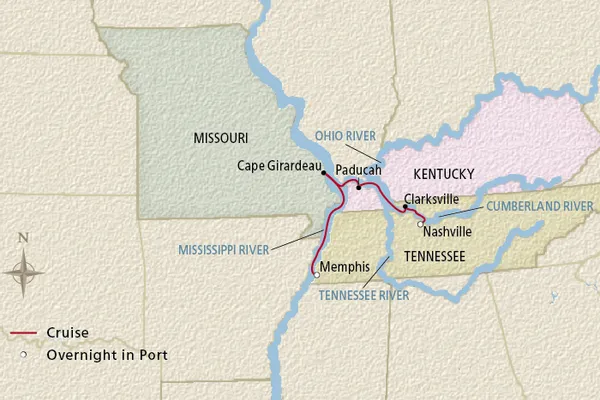
Culture unfolds along the Mississippi River
Revel in the charm of “America’s Great River” as you wind your way along this iconic US waterway. Below, you can learn more about the lively cities and cultural treasures that await you on a journey through America’s heartland. Read on to gain insight into how Memphis barbecue is prepared, delve into the history of one of Missouri’s most charming towns and discover the incredible biodiversity of the Lower Mississippi.

Mississippi
Stretching for 2,350 mi. (3,782 km) down the United States, from Minnesota's Lake Itasca to the Gulf of Mexico, the “Mighty Mississippi” has shaped the country as much as it has American history and culture. Its name is derived from the Ojibwe (Chippewa) language and translates to “great river.” It is North America’s second-longest river—behind the Missouri River—and the fourth-longest in the world. Remarkably, the Mississippi touches 31 of the 50 US states and forms the border of eight: Arkansas, Kentucky, Illinois, Iowa, Mississippi, Missouri, Tennessee and Wisconsin.
During winter, the average monthly temperatures along the river range from 55°F (13°C) in southern Louisiana to 10°F (−12°C) in northern Minnesota. In summer, average monthly temperatures range from 82°F (28°C) at the river’s southern end to 70°F (21°C) in its northernmost portion.
The river’s long history as a natural highway dates back to early Native American populations, and later, 16th-century European explorers. Steamboats appeared on the river beginning in 1811 when the New Orleans was first introduced, spurring a revolution on the river—whereby freight by steamer became the fastest and most cost-effective method of shipping goods. During the Civil War, the Confederacy and the Union vied for control of the river. Although river traffic dwindled as east-west railroads were popularized in the post-war years, the Mississippi remains one of the world’s busiest commercial waterways, flowing past the Great Plains, major mountain systems—the Rockies and the Appalachian Mountains—and some of the most fertile farmland in the US.
The Mississippi is controlled by an elaborate system of levees, dams and spillways. A series of 29 locks and dams on the Upper Mississippi maintains a 9-foot (2.7 m) channel for commercial barge traffic. In contrast, the Lower Mississippi’s route is not impeded by locks or dams, instead relying on a series of levees and dikes to control flooding and make the stretch of water navigable. While floods are a historic problem, they also created the Delta’s fertile soil and led to wide-scale agriculture in the region.
Home to a diverse network of flora and fauna, the Mississippi River includes one of the nation’s largest wetlands, which attracts nearly 40 percent of all ducks, geese and swans in North America. It is estimated that the river supports more than 300 fish species, such as carp, walleyes, paddlefish and catfish.
With all the Mississippi River has to offer, it is no surprise that these waters have provided a source of inspiration for cultural icons such as author Mark Twain, novelist Eudora Welty and lyricist Oscar Hammerstein, among others.

-
Cuisine—Memphis-style barbecue
Of the four barbecue (BBQ) styles found across the US—Texas, Memphis, Kansas and Carolina—Memphis BBQ serves up some of the sweetest and most distinctively delicious flavors. Pitmasters—the chefs who specialize in cooking this kind of cuisine—are partial to using pork in their recipes. The unique blend of spice rubs, use of smoking wood and tangy sauces differentiate these sizzling meats from other BBQ styles.
Packed with flavor, pork ribs, pork butts and pork shoulder are crowned as the most popular BBQ cuts in Memphis. Pitmasters pour their heart into the BBQ cooking method, which involves coating the meat in a thick layer of dry or wet rub and slow cooking the cuts for hours in a large pit filled with high-end charcoal and wood. Hickory wood from regional trees is used for smoking in the pit fire, which adds a rich bacon flavor to the pork.
While spice recipes for rubs vary based on the pitmaster’s formula, most include salt, black pepper, chili powder, paprika and garlic powder, plus other herbs and aromatic spices. Modern recipes call for brown sugar in the rub, creating a sweeter taste. Pork cuts can also be cooked “wet,” which involves basting BBQ sauce over the dry rub before, during and after cooking. Both dry and wet styles are local favorites and can be found on menus throughout the city.
Even though the traditional dry rubs offer plenty of impressively juicy flavors on their own, sauces are often served on the side for dipping or are used in the preparation of “wet” style BBQ. Sauces here are characteristically defined by their tangy sweetness, which comes from key ingredients like tomato sauce (or ketchup), vinegar, brown sugar, mustard and molasses. While Memphis BBQ sauce recipes come in many varieties, they are all crafted with a similar goal in mind: to impress your palate.
-
Culture—Famous figures from Hannibal, Missouri
Located 100 mi. (160 km) north of St. Louis along the Mississippi River, the charming town of Hannibal is best known as the childhood home of author Mark Twain (born Samuel Langhorne Clemens). The characters and locations within his work were deeply influenced by the town where he grew up, which Twain once fondly described as a “town drowsing in the sunshine of a summer’s morning.”
Twain most likely swam or canoed out to Glasscock’s Island in the middle of the Mississippi River, which he later used as the basis for Jackson’s Island in Adventures of Huckleberry Finn, and the labyrinthine Mark Twain Cave (formerly McDowell’s Cave), located just south of town, became McDougal’s Cave in The Adventures of Tom Sawyer.
In addition to the legendary author, Hannibal has also been home to other prominent figures. Two local museums—the Hannibal History Museum and Jim's Journey: Huck Finn Freedom Center—tell the stories of other Hannibalians who achieved fame, including these four influential individuals:
- Philanthropist and activist Margaret Brown famously survived the 1912 sinking of the RMS Titanic, which earned her the nickname “the Unsinkable Molly Brown.” Ironically, she never actually went by Molly; the moniker was given to her posthumously. In her lifetime, she supported several social justice causes, including women’s suffrage and workers’ rights.
- In 1904, 23-year-old athlete George Poage became the first Black American to win an Olympic medal. Many Black athletes chose not to participate in the St. Louis Olympic Games because, at that time, spectators were still segregated. Poage made his own statement by remaining in the games. He further left his mark by winning two bronze medals in the 200- and 400-meter hurdles.
- Admiral Robert E. Coontz sailed with the Great White Fleet, a group of 16 US Navy battleships of the Atlantic Fleet that completed a journey around the globe in 1909 to display US naval power to the world. In 1923, Coontz returned to sea as Commander-in-Chief to lead 57 vessels on a trans-Pacific voyage to New Zealand and Australia—the first massed deployment since the Great White Fleet. His 1934 memoir, From the Mississippi to the Sea, details his early life in Hannibal and his navy career.
- Civic leader and educator Hiawatha Moore Crow, who was moved by her family to Hannibal as an infant, grew up to become the first Black American elected to the Hannibal City Council. She was also the third woman to serve on the council in 1983, and then again after her re-election in 1987. A former schoolteacher, she was a prominent figure in Hannibal who participated in other community and church activities during her life. She died in Hannibal in 1999.
-
Nature—The ecosystems of the Lower Mississippi
With such entrancing landscapes and rich wildlife, it is no wonder the Mississippi River Valley served as inspiration for many authors of the late 18th and early 19th centuries, like the great Mark Twain. The Lower Mississippi in particular—also known as the Mississippi Alluvial Valley (MAV) or “The Delta”—boasts some of the most impressive ecosystems, wildlife and landscapes in the region.
The Lower Mississippi Valley is the largest forested wetland ecosystem in North America. Spanning over 22 million acres (89,000 sq km) from the confluence of the Mississippi and Ohio Rivers at Cairo, Illinois to the northern Gulf of Mexico, these wetlands were formed over thousands of years as river floodwaters deposited myriad layers of sediment. With a drainage basin that accounts for nearly half of the coterminous US, this floodplain features a unique patchwork of ridges, swales and backswamps. Because of its grand scope, ranging from interior forested wetlands to barrier islands on the Gulf of Mexico, the Mississippi Alluvial Valley nurtures several distinct natural habitats and ecosystems. From freshwater swamps, bayous and estuaries to immense hardwood forests and salt marshes, this area is home to millions of birds, fish, bobcats, alligators, turtles, black bears and more.
Biologists affectionately call this region “the Heart of the Mississippi Flyway” because more than forty percent of North America’s waterfowl and sixty percent of US bird species migrate here for winter. This is also the nesting ground for more than one hundred distinct species of land birds. The river and its tributaries support over ninety species of fish, including catfish, carp, trout, bass and more. There are also around fifty freshwater mussel species.
One of Mother Nature’s great wonders, the Mississippi Delta is a splendid source of nourishment and beauty for humans and animals alike. Everyone can enjoy the offerings of this special environment, whether by taking a kayak or boat trip through the secluded backwaters of the river or hiking through one of the many state parks. Wherever you find yourself in the Lower Mississippi, this rich and enchanting stretch of America is sure to inspire.
Mississippi Highlights
A voyage along the “Mighty Mississippi” offers a distinctive type of cross-country journey for the curious explorer—one that allows you to be immersed in American history and culture. Here are some of the notable sights and activities you may experience on a voyage along this impressive waterway:
- Listen to authentic New Orleans jazz and Delta blues
- Taste Cajun & Creole dishes, like gumbo and shrimp étoufée
- Discover historic Southern estates in Natchez
- Visit the Civil War site where the Battle of Vicksburg ended
- Tour Graceland, the iconic Memphis estate of Elvis Presley
- Sip Kentucky’s famous bourbon at a local distillery
- Take in panoramic views from the St. Louis Gateway Arch
- See the historic Missouri town where Mark Twain grew up
- Sample cheese at a family-run dairy farm in Iowa
- Go behind the scenes at Dubuque's real-life Field of Dreams
- Explore Norwegian-American history at the Vesterheim Museum
- Learn about conservation at the National Eagle Center
Destination Insight Videos
-
Discover Mississippi Delta bird species with our partners at the Cornell Lab of Ornithology (10:32)
Learn about the birds of the Mississippi Delta during an informative film created by the Cornell Lab of Ornithology, which examines various species that can be observed on our Mississippi River voyages.
-
Make a rock ‘n’ roll pilgrimage to Elvis Presley’s Graceland with Tom Brown & Angie Marchese (21:44)
Enjoy a behind-the-scenes glimpse at Graceland, the Memphis home of Elvis Presley, who resided there from 1957 to 1977. One of the most famous places in music history, the Graceland mansion features iconic spaces such as the Jungle Room, where Elvis wrote many of his hit tunes. During this guided tour, follow radio host Tom Brown and Angie Marchese, Vice President of Archives & Exhibits at Graceland, as they share some of the hidden locations and little-known artifacts from the home’s collection.
-
The New Orleans Jazz All-Stars with Wendell Brunious (43:47)
Let the good times roll as we re-air a riveting performance by the New Orleans All-Stars. Founded by trumpeter and bandleader Wendell Brunious and inspired by the legendary Louis Armstrong group of the same name, the New Orleans All-Stars is composed of leading local jazz artists. Enjoy this foot-tapping performance recorded at the New Orleans Jazz Museum.
-
Exploring the Vesterheim Museum with Laurann Gilbertson (39:23)
Uncover the fascinating history of Norwegian culture in America with Laurann Gilbertson, chief curator of Vesterheim, the Norwegian American museum and heritage center in lowa. Showcasing the most extensive collection of Norwegian American artifacts in the world-more than 33,000 in all-Vesterheim's exhibitions focus on the Norwegian American experience and highlight the best in historic and contemporary Norwegian folk and fine arts. Join Laurann as she takes viewers on a guided tour of the museum's collections while answering questions during the livestream.
Mississippi Travel FAQ
All-Inclusive Itineraries—Mississippi
Choose one of our enriching, all-inclusive voyages and discover the many benefits of exploring in Viking comfort.



